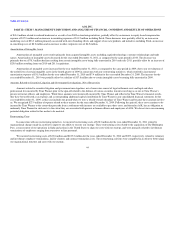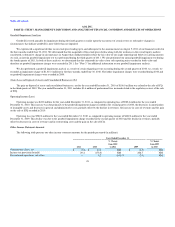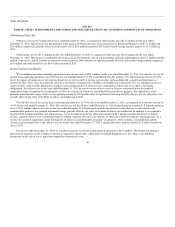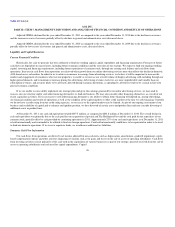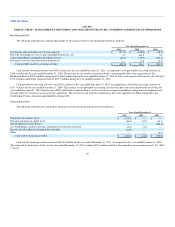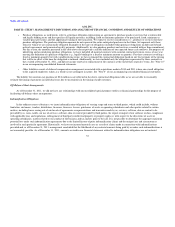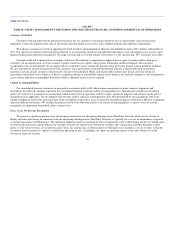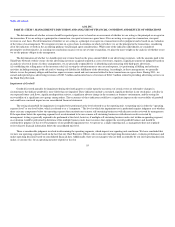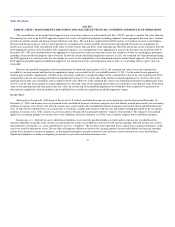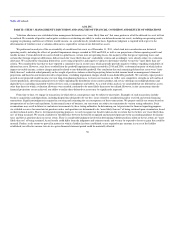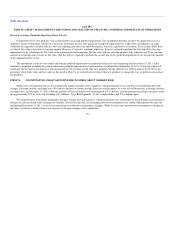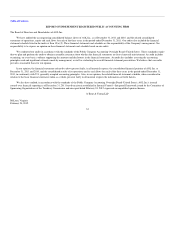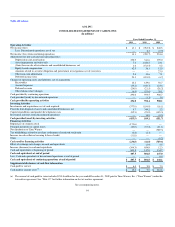America Online 2011 Annual Report Download - page 58
Download and view the complete annual report
Please find page 58 of the 2011 America Online annual report below. You can navigate through the pages in the report by either clicking on the pages listed below, or by using the keyword search tool below to find specific information within the annual report.
Table of Contents
AOL INC.
PART II—ITEM 7. MANAGEMENT'S DISCUSSION AND ANALYSIS OF FINANCIAL CONDITION AND RESULTS OF OPERATIONS
Customer Credit Risk
Customer credit risk represents the potential for financial loss if a customer is unwilling or unable to meet its agreed-upon contractual payment
obligations. Credit risk originates from sales of advertising and subscription access service and is dispersed among many different counterparties.
We had gross accounts receivable of approximately $319.8 million and maintained an allowance for doubtful accounts of $8.3 million at December 31,
2011. Our exposure to customer credit risk relates primarily to our advertising customers and individual subscribers to our subscription access service, and is
dispersed among many different counterparties. No single customer had a receivable balance at December 31, 2011 greater than 10% of total net receivables.
Customer credit risk is monitored on a company-wide basis. We maintain a comprehensive approval process prior to issuing credit to third-party
customers. On an ongoing basis, we track customer exposure based on news reports, rating agency information and direct dialogue with customers.
Counterparties that are determined to be of a higher risk are evaluated to assess whether the payment terms previously granted to them should be modified.
We also continuously monitor payment levels from customers, and a provision for estimated uncollectible amounts is maintained based on historical
experience and any specific customer collection issues that have been identified. While such uncollectible amounts have historically been within our
expectations and related reserve balances, if there is a significant change in uncollectible amounts in the future or the financial condition of our counterparties
across various industries or geographies deteriorates further, additional reserves may be required.
Critical Accounting Policies
Our consolidated financial statements are prepared in accordance with GAAP, which require management to make estimates, judgments and
assumptions that affect the amounts reported in the consolidated financial statements and the accompanying notes. Management considers an accounting
policy to be critical if it is important to our financial condition and results of operations, and if it requires significant judgment and estimates on the part of
management in its application. The development and selection of these critical accounting policies have been determined by our management. Due to the
significant judgment involved in selecting certain of the assumptions used in these areas, it is possible that different parties could choose different assumptions
and reach different conclusions. We consider the policies related to the following matters to be critical accounting policies: (a) gross versus net revenue
recognition; (b) impairment of goodwill; and (c) income taxes.
Gross versus Net Revenue Recognition
We generate a significant portion of our advertising revenues from our advertising offerings on the Third Party Network, which consist of sales of
display and video advertising. In connection with our advertising offerings on the Third Party Network, we typically act as or use an intermediary or agent in
executing transactions with third parties. The significant judgments made in accounting for these arrangements relate to determining whether we should report
revenue based on the gross amount billed to the customer or on the net amount received from the customer after commissions and other payments to third
parties. To the extent revenues are recorded on a gross basis, any commissions or other payments to third parties are recorded as costs of revenues so that the
net amount (gross revenues less expense) is reflected in operating income. Accordingly, the impact on operating income is the same whether we record
revenue on a gross or net basis.
54


